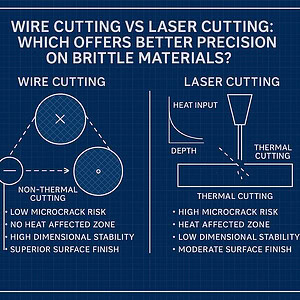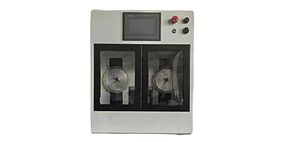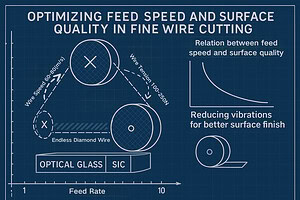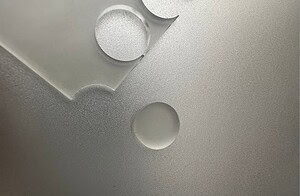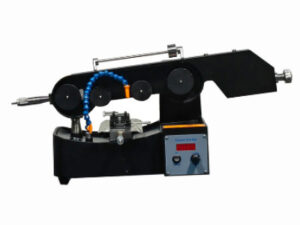Comparing Wire Cutting and Laser Cutting Methods
소개
Precision cutting is a fundamental requirement across semiconductor, optics, ceramics, carbon composites, and other advanced materials. As components become thinner and performance demands increase, manufacturers often compare 와이어 절단 대 레이저 절단 to determine which method delivers higher accuracy, lower thermal effects, and more stable surface quality.
Laser cutting has become popular in sheet metal fabrication and thin-film processing due to its speed and flexibility. However, when cutting hard and brittle materials such as sapphire, silicon carbide (SiC), quartz, optical glass, and advanced ceramics, laser-generated heat can create microcracks, thermal stress, and recast layers.
대조적으로, 다이아몬드 와이어 커팅—especially endless-loop systems—operates as a non-thermal cutting method. It produces low cutting forces, minimizes vibration, and provides excellent microcrack control, making it a strong candidate for high-value brittle substrates.
This article provides a detailed process comparison between wire cutting and laser cutting based on physics, surface integrity, cutting precision, kerf width analysis, and downstream processing impact.
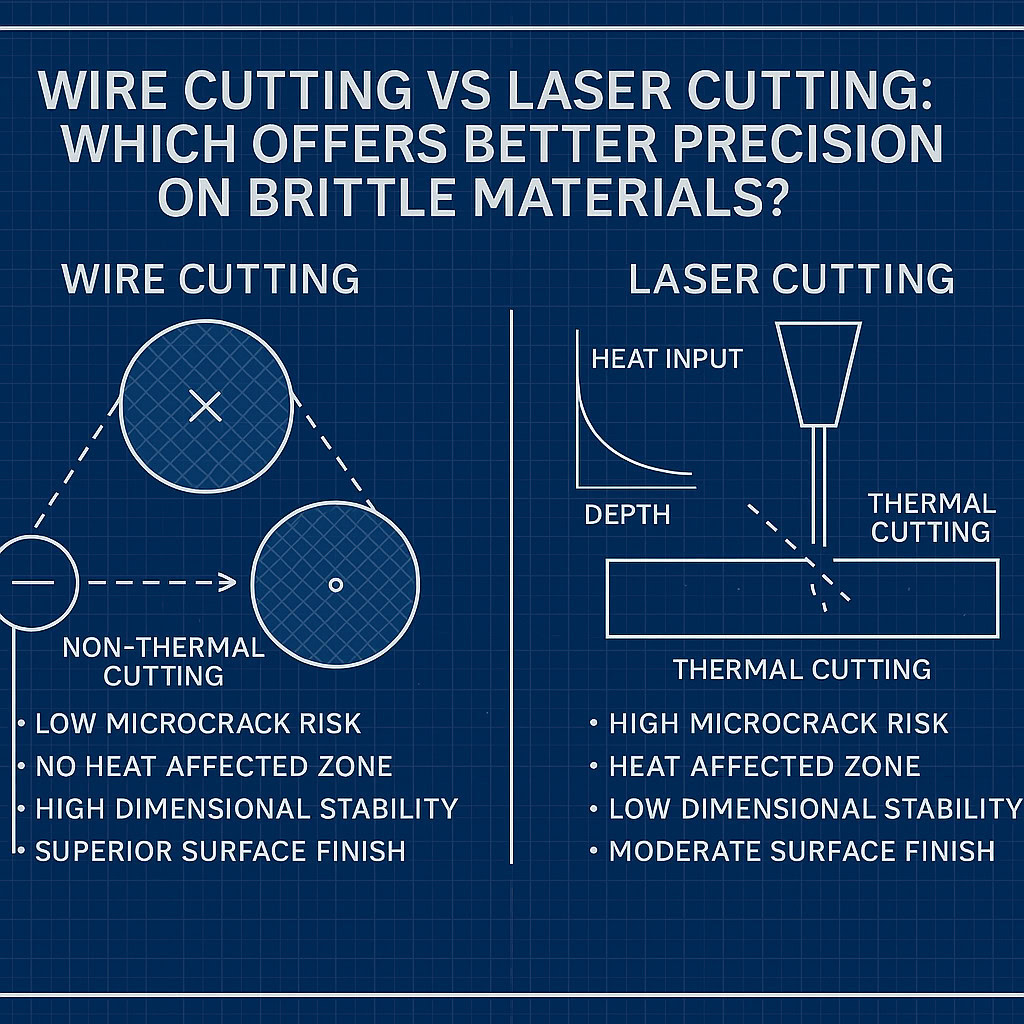
Thermal vs Non-Thermal Cutting Behavior
The largest difference between wire cutting and laser cutting lies in the thermal impact.
Laser Cutting: A Thermal Process
Laser cutting relies on localized melting, vaporization, and heat conduction. This creates:
- Heat-affected zones (HAZ)
- Thermal stresses
- Microcracks near the cutting edge
- Material recast or debris
- Possible change in material properties (especially optical materials)
For metals, these issues are manageable.
For brittle materials like sapphire or SiC, they significantly reduce yield.
Wire Cutting: A Non-Thermal Process
Diamond wire removes material mechanically through abrasive micro-cutting.
Key advantages:
- No melting
- No thermal gradient
- No recast layer
- No heat-affected zone
This non-thermal cutting behavior ensures the structural integrity of brittle materials while reducing the risk of micro-cracks during slicing.
Microcrack Control and Surface Integrity
Laser Cutting Microcrack Risks
- Rapid heating + rapid cooling = thermal shock
- Crack propagation along the crystalline plane
- Subsurface damage requiring secondary polishing
- Poor stability for thick substrates
Laser cutting is best suited for thin films or low-value materials where thermal marks are acceptable.
Wire Cutting Microcrack Performance
Diamond wire applies distributed abrasive force across thousands of cutting points along the loop.
This creates:
- Uniform stress distribution
- Low chip load
- Very low initiation of micro-fractures
- Smooth and predictable surface textures
For sapphire and SiC, wire cutting typically reduces subsurface damage by 30–60% compared to laser processing.
Precision, Kerf Width, and Dimensional Accuracy
Laser Cutting Precision Characteristics
Laser spot size determines kerf width.
Advantages:
- Fine laser spots reach 20–50 µm
- Good for 2D profiles
- High speed for thin materials
Limitations:
- Heat expansion affects dimensional stability
- Edge tapering may occur
- Lower performance on thick, brittle substrates
Wire Cutting Precision Characteristics
Wire cutting offers extremely stable geometry:
- Kerf width: 0.12–0.35 mm depending on wire diameter
- Excellent thickness accuracy
- No thermal deformation
- Straight cuts even in 200–500 mm blocks
- Highly stable for multi-slice operations
For precision slicing applications like sapphire wafers, wire cutting generally delivers more consistent slice thickness and better dimensional accuracy.
Cutting Different Materials: SiC, Sapphire, Glass, Ceramics
레이저 커팅
- Excellent for polymers, metals, thin films
- Poor for heat-sensitive optical materials
- Limited performance on thick crystalline substrates
- Not suitable for porous graphite or composite blocks
전선 절단
- Ideal for SiC and sapphire
- Strong performance on quartz and optical glass
- Superior control on advanced ceramics(Al₂O₃, ZrO₂)
- Best method for large graphite and carbon-composite blocks
Wire cutting is widely preferred in semiconductor wafering, optical component manufacturing, and precision ceramics machining.
Cost, Throughput, and Maintenance Comparison
레이저 커팅
- High equipment cost
- High energy consumption
- Requires optical path cleaning & calibration
- Fast for thin materials
- Poor economics for thick hard substrates
전선 절단
- Lower operational cost
- High throughput for multi-slice cutting
- Minimal consumables (diamond wire + coolant)
- Maintenance primarily in pulleys and tension systems
- Better yield for brittle substrates, reducing scrap cost
Performance Comparison Table
| 기능 | 레이저 커팅 | 다이아몬드 와이어 커팅 |
|---|---|---|
| 절단 메커니즘 | Thermal | Non-thermal |
| Microcrack Risk | 높은 | 매우 낮음 |
| Heat-Affected Zone | 예 | 없음 |
| 커프 폭 | 매우 좁다 | Narrow & stable |
| Precision on Thick Materials | 중간 | Very high |
| Surface Smoothness | 보통 | Excellent |
| 적합한 재료 | Metals, polymers, thin films | Sapphire, SiC, glass, ceramics, graphite |
| 비용 효율성 | 중간 | High(especially multi-slice) |
결론
When comparing 와이어 절단 대 레이저 절단, the choice depends heavily on material type and precision requirements. For brittle, heat-sensitive, or high-value materials, diamond wire cutting offers clear benefits:
- non-thermal cutting
- microcrack control
- extremely stable dimensional accuracy
- uniform surface integrity
- excellent performance on SiC, sapphire, optical glass, ceramics, and graphite
Laser cutting remains advantageous for metals, composites, and thin films, but wire cutting is the superior method for structural precision and material protection.
👉 Learn about our non-thermal precision cutting solutions.https://www.endlesswiresaw.com/wire-saws
자주 묻는 질문 — Wire Cutting vs Laser Cutting
1. Which method provides better precision in brittle materials?
Wire cutting provides better stability in brittle materials because it is a non-thermal cutting method, avoiding thermal shock and microcrack formation.
2. Does laser cutting cause microcracks in sapphire or SiC?
Yes. Laser cutting creates thermal gradients that can lead to crack propagation in crystals like sapphire and silicon carbide.
3. Which process delivers better surface smoothness?
Wire cutting delivers smoother surfaces with fewer defects, especially on optical glass, ceramics, and graphite.
4. Is wire cutting slower than laser cutting?
Laser cutting is faster for thin materials.
Wire cutting is more efficient for large blocks or multi-slice wafer slicing, offering better overall yield.
5. Which process is more cost-effective for high-value materials?
Wire cutting is more cost-effective because it reduces scrap rate, minimizes subsurface damage, and provides excellent dimensional control.

